Home | Category: Hittites and Phoenicians
ORIGIN OF THE PHOENICIANS
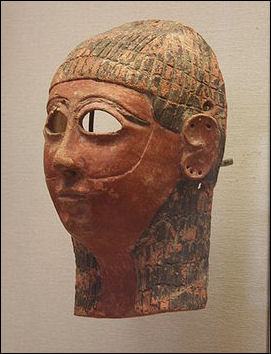
Carthage head The Phoenicians were a Semitic-speaking people. Nobody knows who they were or where they came from. Ancient Phoenicia more or less corresponded with ancient Lebanon with extensions north into present-day Syria and south into present-day Israel and was best viewed as a group ports with their surrounding hinterlands and mountains in their backyard and the sea at their door step.
From the best that can be ascertained the Phoenicians were a mix of peoples and states that eventually became a people of their own. They emerged as a significant cultural and political force around 1100 B.C. Early Phoenicians lived in a small area of the coast in present-day Lebanon. The land was good. They had pastures, orchards and vineyards. Looked outwards towards the sea to expand. From the 9th to 6th centuries B.C. they dominated the Mediterranean Sea by extending a string of colonies throughout the region.
In the early 2000s, Spencer Wells, a geneticist at Harvard, and Pierre Zalloua, a geneticist at the American University in Beirut, took blood samples from people in areas where the Phoenicians lived in Lebanon, Tunisia and Spain to gain some insight into where the Phoenicians came from, who they were and what happened to them based on clues that could be gleaned from their DNA.
Wells and Zalloua also were interested in testing a couple of hypothesis. One was that both Muslims and Christians in Lebanon were descendants of Phoenicians. In the civil war era, Maronite Christians claimed they were they descendants of Phoenicians and the Muslims were not. The issue of Phoenician descendant became so divisive that the word Phoenician became taboo and was even absent from Phoenician displays in museums.
Genetic studies indicate that many of the people in Lebanon are descendants of Phoenicians and Canaanites while their impact in North Africa was minimal. DNA evidence indicates that most people that live there are indigenous North Africans and they did not come from the Middle East either during Phoenician era or during the Islamic expansion in the A.D. 7th century. DNA studies in Lebanon also reveal that both modern Muslims and Christians there share common Phoenician ancestors going back more than 5,000 years. On what he surmised about the Phoenician, Wells told National Geographic: “Apparently they didn’t interbreed much. They seem to have stuck mostly to themselves. They were a slippery people. They came, they traded, they left. I guess that only adds to their mystery.”
Websites on Mesopotamia: Internet Ancient History Sourcebook: Mesopotamia sourcebooks.fordham.edu ; International Association for Assyriology iaassyriology.com ; Institute for the Study of Ancient Cultures, University of Chicago isac.uchicago.edu ; University of Chicago Near Eastern Languages and Civilizations nelc.uchicago.edu ; University of Pennsylvania Near Eastern Languages & Civilizations (NELC) nelc.sas.upenn.edu; Penn Museum Near East Section penn.museum; Ancient History Encyclopedia ancient.eu.com/Mesopotamia ; British Museum britishmuseum.org ; Louvre louvre.fr/en/explore ; Metropolitan Museum of Art metmuseum.org/toah ; Ancient Near Eastern Art Metropolitan Museum of Art metmuseum.org; Iraq Museum theiraqmuseum ABZU etana.org/abzubib; Archaeology Websites Archaeology News Report archaeologynewsreport.blogspot.com ; Anthropology.net anthropology.net : archaeologica.org archaeologica.org ; Archaeology in Europe archeurope.com ; Archaeology magazine archaeology.org ; HeritageDaily heritagedaily.com; Live Science livescience.com/
RECOMMENDED BOOKS:
“Phoenicians: Lebanon's Epic Heritage” by Sanford Holst (2005) Amazon.com;
“Out of Arabia: Phoenicians, Arabs, and the Discovery of Europe” by Warwick Ball (2009) Amazon.com;
“Sea Peoples of the Bronze Age Mediterranean C.1400 BC–1000 BC” by Andrea Salimbeti (2015) Amazon.com;
“Phoenician Secrets: Exploring the Ancient Mediterranean” by Sanford Holst (2011) Amazon.com;
“The Phoenicians: The Purple Empire of the Ancient World” by Gerhard Herm (1973) Amazon.com;
“In Search of the Phoenicians” by Josephine Quinn (2017) Amazon.com;
"The Phoenicians" by Donald Harden Amazon.com;
"Phoenicians" by Glenn Markoe (Berkeley: University of California Press, 2000) Amazon.com;
“The Oxford Handbook of the Phoenician and Punic Mediterranean” by Carolina López-Ruiz, Brian R. Doak (2019) Amazon.com;
“Carthage Must be Destroyed: The Rise and Fall of an Ancient Mediterranean Civilization” by Richard Miles (2010) Amazon.com;
Early History of the Phoenicians
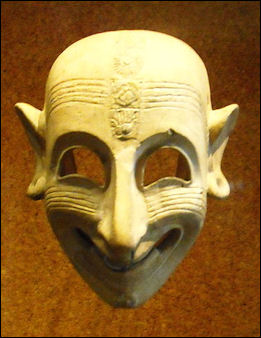 Phoenicians inhabited the coastal cities, Tyre, Sidon, Byblos and Arwad, in what is now Lebanon and southern Syria. However, since their writings were made on papyrus, little remains except what has been written about them by Greek and Egyptian scholars. [Source: AFP, May 26, 2016]
Phoenicians inhabited the coastal cities, Tyre, Sidon, Byblos and Arwad, in what is now Lebanon and southern Syria. However, since their writings were made on papyrus, little remains except what has been written about them by Greek and Egyptian scholars. [Source: AFP, May 26, 2016]
According to the Metropolitan Museum of Art: “With the exception of Byblos, which had been a flourishing center from at least the third millennium B.C., the Phoenician cities first emerged as urban entities around 1500 B.C. As Egyptian and Near Eastern documents record, the Late Bronze Age (1550–1200 B.C.) was a time of economic prosperity for these trading centers. Confined to a narrow coastal strip with limited agricultural resources, maritime trade was a natural development. [Source: Department of Ancient Near Eastern Art. Heilbrunn Timeline of Art History, Metropolitan Museum of Art, October 2004 \^/]
"With the decline of Egyptian influence about 1200 B.C., the cities were freed from foreign domination. The ultimate collapse of Egyptian power in the region occurred about 1175 B.C. at the hands of the Sea Peoples, of whom the best known are the Philistines. Along with Israelites, they settled in the southern Levant. For reasons not yet fully understood, the massive disruptions caused elsewhere in the Levant appear to have had a minimal effect upon the Phoenician coastal centers. There is therefore much continuity in Phoenician traditions from the Late Bronze Age until the Hellenistic period around 300 B.C.” \^/
Canaanites, First Inhabitants of Lebanon
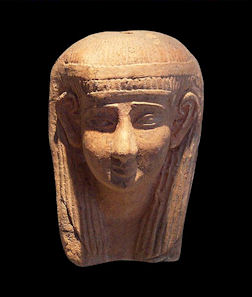
Phoenician mask The Phoenicians evolved from the Canaanites, a Semitic tribe of the Middle East, which also gave birth to the people of Ugariti, the Hebrews (Jews) and later the Arabs. The Canaanites were the earliest inhabitants of Lebanon according to written historical records. They were called Sidonians in the Bible. Sidon was one of their cities. Artifacts unearthed at Byblos have been dated to 5000 B.C. They were produced by Stone Age farmers and fishermen. They were repelled by Semitic tribes people who arrived as early as 3200 B.C.
Canaanites ousted the Hittites, invaders from present-day Turkey; overpowered the Ugarit people on the Syrian coast and drove southward until they stopped Ramasses III, the pharaoh of Egypt. The Canaanites also had encounters with the Hyksos, a people who conquered lower kingdom of Egypt; and the Assyrians.
According to the Bible, the ancient Canaanites, were idol worshipers who practiced human sacrifice and engaged in deviant sexual activity. They reportedly conducted human sacrifices in which children were immolated in front of their parents on stone altars, known as Tophets, dedicated to the mysterious dark god Molech. We have some idea what the Canaanites looked like. An Egyptian wall painting from 1900 B.C. depicts Canaanite dignitaries visiting the pharaoh. The Canaanites have Semitic facial features, and dark hair, which the women wear in long tresses and the men have styled in mushroom- shaped bundles on the tops of their heads. Both sexes wore bright red and yellow clothes — long dresses for women and kilts by the men.
From what scholars have been able to ascertain, the Canaanites were a largely urban people that originated in eastern Syria, migrated southward along the Mediterranean lived mostly between the Jordan River and the Mediterranean in what is now Israel. They never were very strong or established an empire and in fact were often overrun by the great empires of Mesopotamia, Egypt and Anatolia. By around 1100 B.C. they had been absorbed into the Israelites.
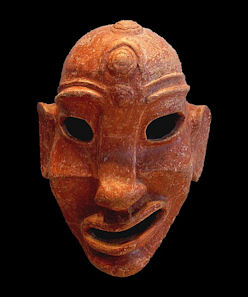
Phoenician mask Canaanites buried 4,000 years ago were folded up with their arms and legs crossed and placed in burial pots, sometimes wearing a necklace made with gold, rock crystal and carnelian beads. The burial pot and the position of the dead, it is thought, was intended to replicate the position of a newborn in a womb ready to be reborn into the afterlife. At Ashkelon (see Below) Canaanite families placed corpses in burial chambers and kept them there until the flesh rotted off, a process that took several months, then they would bury the bones in recesses and corners of the chambers. Over time the remains of a lot of individuals could get crammed inside. At Ashkelon babies were buried with Egyptians scarabs, magical charms, suggesting, archaeologists say, that they were accorded the status of full-fledged adults.
The Canaanites are believed to have been the first people to possess an alphabet. A 13th century B.C. tablet with column of Canaanite words was found at Ashkelon. Believed to have used to teach scribes languages, the tablet appears to have contained other columns with other languages, perhaps the Semitic cuneiform language of Akkadian and another unrelated tongue, possibly Hurrian or Hittite.
The desolate Valley of Hinom, just south of the Old City in Jerusalem, is where the ancient Canaanites reportedly conducted human sacrifices in which children were immolated in front of their parents. Canaan objects, excavated by archaeologists include an 18.5-inch-long ivory horn with gold bands, circa 1400 B.C., unearthed at Megiddo in present-dat Israel, and a vessel with the Egyptian hawk-god Hyksos, unearthed in Ashkelon.
Canaanites at Ashkelon
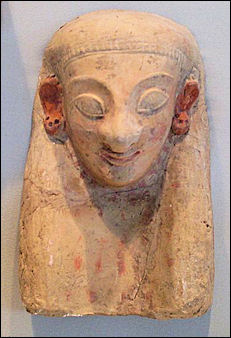 Around 1850 B.C. Canaanites occupied the coastal settlement of Ashkelon, one of the largest and richest seaports in the Mediterranean in ancient times. Ashkelon was located in present-day Israel, 60 kilometers south of Tel Aviv, and dates back at least to 3500 B.C. Over the centuries it was occupied by Phoenicians, Greeks, Romans, Byzantines and Crusaders. Conquered by the Egyptians and Babylonians, it was probably visited by Samson, Goliath, Alexander the Great, Herod and Richard the Lion-hearted. The presence of all these cultures and historical periods means the site is rich archaeologically but also difficult and complex to sort through. [Source: Rick Gore, National Geographic January 2001]
Around 1850 B.C. Canaanites occupied the coastal settlement of Ashkelon, one of the largest and richest seaports in the Mediterranean in ancient times. Ashkelon was located in present-day Israel, 60 kilometers south of Tel Aviv, and dates back at least to 3500 B.C. Over the centuries it was occupied by Phoenicians, Greeks, Romans, Byzantines and Crusaders. Conquered by the Egyptians and Babylonians, it was probably visited by Samson, Goliath, Alexander the Great, Herod and Richard the Lion-hearted. The presence of all these cultures and historical periods means the site is rich archaeologically but also difficult and complex to sort through. [Source: Rick Gore, National Geographic January 2001]
Canaanite Ashkelon covered 60 hectares. The great wall that surrounded it when it was at its height was an arc over two kilometers long, with the sea on the other side. Just the ramparts of the wall — not the wall itself — were up to 16 meters high and 50 meters thick. The towered wall on top of it may have risen to a height of 35 meters. The Canaanites built a vaulted corridor with arched gateways in the city’s mud-brick north wall. The site’s excavation has been overseen by Harvard archaeologist Lawrence Stager since 1985.
The Canaanites occupied Ashkelon from 1850 until 1175 B.C. Sanger told National Geographic, “They came by the boatload . They had master craftsmen and a clear idea of what they wanted to build — big fortified cities. With plentiful supplies of fresh water, it was a major exporters of wine, olive oil, wheat and livestock. Studies of their teeth indicate they ate a lot sand in their food and their teeth wore down quickly.”
Among the important finds made at Ashkelon were the oldest arched gateway ever found and a silver-plated bronze calf, a symbol of Baal, reminiscent of the huge golden calf mentioned in Exodus, found in 1990 by Harvard archaeologists. Ten centimeters tall and dated to 1600 B.C. the calf was found within its own shrine, a beehive-shaped pottery vessel. Baal was the Canaanites storm god. The statue is now on display in the Israel Museum.
At its height Canaanite Ashkelon was probably home to 15,000 people , quite a large number in ancient times. By comparison Babylon at that time might have had 30,000 residents. The Egyptians considered the Canaanites to be rivals and cursed the Ashkelon kings by writing their names on figurines and smashing them to magically destroy their power. Stager has suggested that the Canaanites perhaps were the Hyksos, mysterious people from the north that conquered the ancient Egyptians, based in the discovery of artifacts in Egypt from the Hyskso period that are identical with those found in Canaanite Ashkelon. Around 1550 B.C. the Egyptians expelled the Hyksos and dominated Ashkelon and Canaan.
Ugarit
Ugarit was an important 14th century B.C. Mediterranean port located on the Syrian coast, 10 kilometers north of the Syrian port of Latakia on the Mediterranean coast, east of the northeast coast of Cyprus. It was an the next great Canaanite city to arise after Ebla. Tablets found at Ugarit indicated it was involved in the trade of box and juniper wood, olive oil, wine.

Ugaritian head
According to the Metropolitan Museum of Art:. “Its ruins, in the form of a mound or tell, lie half a mile from the shore. Although the name of the city was known from Egyptian and Hittite sources, its location and history were a mystery until the accidental discovery in 1928 of an ancient tomb at the small Arab village of Ras Shamra. “The city's location ensured its importance through trade. To the west lay a good harbor (the bay of Minet el Beidha), while to the east a pass led to the heart of Syria and northern Mesopotamia through the mountain range that lies parallel with the coast. The city also sat astride an important north-south coastal trade route linking Anatolia and Egypt.[Source: Department of Ancient Near Eastern Art. "Ugarit", Heilbrunn Timeline of Art History, New York: The Metropolitan Museum of Art, October 2004 \^/]
“Ugarit was a flourishing city, its streets lined with two-story houses dominated on the northeastern side of the tell by an acropolis with two temples dedicated to the gods Baal and Dagan. A large palace, built from finely dressed stones and consisting of numerous courtyards, pillared halls, and a columned entrance gate, occupied the western edge of the city. In a special wing of the palace were a number of rooms apparently devoted to administration, since hundreds of cuneiform tablets were discovered there covering almost all aspects of the life of Ugarit from the fourteenth to the twelfth century B.C. It is clear that the city dominated the surrounding land (though the full extent of the kingdom is uncertain).. \^/
“Merchants figure prominently in Ugarit's archives. The citizens engaged in trade and many foreign merchants were based in the state, for example from Cyprus exchanging copper ingots in the shape of ox hides. The presence of Minoan and Mycenaean pottery suggests Aegean contacts with the city. It was also the central storage place for grain supplies moving from the wheat plains of northern Syria to the Hittite court.” \^/
Books: Curtis, Adrian Ugarit (Ras Shamra). Cambridge: Lutterworth, 1985. Soldt, W. H. van "Ugarit: A Second-Millennium Kingdom on the Mediterranean Coast." In Civilizations of the Ancient Near East, vol. 2, edited by Jack M. Sasson, pp. 1255–66.. New York: Scribner, 1995.
Ugarites and the First Alphabet
According to the Guinness Book of Records, the earliest example of alphabetic writing was a clay tablet with 32 cuneiform letters found in Ugarit, Syria and dated to 1450 B.C. The Ugarits condensed the Eblaite writing, with its hundreds of symbols, into a concise 30-letter alphabet that was the precursor of the Phoenician alphabet.
The Ugarites reduced all symbols with multiple consonant sounds to signs with a single consent sound. In the Ugarite system each sign consisted of one consonant plus any vowel. That the sign for “p” could be “pa,” “pi” or “pu.” Ugarit was passed on to the Semitic tribes of the Middle east, which included the Phoenician, Hebrews and later the Arabs.
Ugarit texts refer to deities such as El, Asherah, Baak and Dagan, previously known only from the Bible and a handful of other texts. Ugarit literature is full of epic stories about gods and goddesses. This form of religion was revived by the early Hebrew prophets. An 11-inch-high silver-and-gold statuette of a god, circa 1900 B.C., was unearthed at Ugarit in present-day Syria.
The Ugarit alphabet was passed on to the Semitic tribes of the Middle East, which included the Phoenicians, Hebrews and later the Arabs.

Ugaratic letters
Sea Peoples
Some archeologist and historians believe a mysterious group known as the Sea People — perhaps ancestors of the Minoans — might have migrated to Lebanon around 1200 B.C. and mixed with local Canaanites to create the Phoenicians.
Maria Eugenia Aubet, a leading Phoenician expert at Pempeu Fabra University in Barcelona, told National Geographic: “I think they became friends, Phoenician material culture shows so many elements from the Sea Peoples. The Phoenicians learned from them how to build harbors, moorings, docks, and piers. The Sea Peoples, like the Phoenicians, were excellent navigators — and how they knew the routes west to the rich sources of metals.”
DNA evidence seems to indicate the impact of the Sea People, if they existed, were a cultural and technological group, not a blood group. The geneticist Wells told National Geographic, “The Sea People apparently had bo significant genetic impact on populations in the Levant.”
See Separate Article: SEA PEOPLES africame.factsanddetails.com

Egyptian relief of Sea People prisoners
Philistines
The great enemies of the post-Moses Hebrews were the Philistines, a tribe that arrived in Canaan from Crete and lived along the Mediterranean coast in cities like Ekron (20 miles southwest of Jerusalem). Delilah was sent by the Philistines to discover Samson's strength. The Philistines themselves killed the Hebrew King Saul. Goliath, the giant slain by David, was also a Philistine.
The Philistines were a seafaring people that settled on the Palestine coast in the 12th century B.C. They brought early Greek culture to Holy Land and are thought to have originated from Aegean region. They were one of about a half dozen or more Sea People that arrived in the eastern Mediterranean in the 12th century B.C. The were expert metalsmiths and similar to Phoenicians in some ways.
In the Bible the Philistines were characterized as thugish destroyers. The word Philistine has come to mean a hedonistic, uneducated person. The American Heritage Dictionary defines a Philistine as a “smug, ignorant, especially middle-class person who is regarded as being indifferent or antagonistic to artistic and cultural values.”
The word Palestine was coined by the Romans and derived from Philistia, or "land of the Philistines." The Bible is the only lengthy written source on the Philistines. The bad rap the Philistines get seems to be based on the fact hat they fought with the Israelites for the better part of two centuries.
See Separate Articles: HISTORICAL PHILISTINES: WHERE THEY LIVED AND THEORIES ABOUT THEIR ORIGIN: africame.factsanddetails.com BIBLICAL PHILISTINES: GIANTS, STORIES — AND UNDESERVED BAD RAP?: africame.factsanddetails.com
Phoenicians and Modern Lebanon
 Modern-day Lebanese look upon their Phoenician heritage with pride. Although the vast majority of them descended from Arabs, they prefer to refer themselves as Phoenicians as opposed too Muslims, Christians, Arabs or even Lebanese.
Modern-day Lebanese look upon their Phoenician heritage with pride. Although the vast majority of them descended from Arabs, they prefer to refer themselves as Phoenicians as opposed too Muslims, Christians, Arabs or even Lebanese.
Fisherman in Lebanon still chant "El...EEE...sa, El...EEE...sa," which is believed to have originally been and ode to Elisa, the Princess of Tyre (Virgils Dido)
Genetic studies indicate that many of the people in Lebanon are descendants of Phoenicians and Canaanites while their impact in North Africa was minimal. DNA evidence indicates that most people that live there are indigenous North Africans and they did not come from the Middle East either during Phoenician era or during the Islamic expansion in the A.D. 7th century. DNA studies in Lebanon also reveal that both modern Muslims and Christians there share common Phoenician ancestors going back more than 5,000 years. On what he surmised about the Phoenician, Wells told National Geographic: “Apparently they didn’t interbreed much. They seem to have stuck mostly to themselves. They were a slippery people. They came, they traded, they left. I guess that only adds to their mystery.”
Phoenician DNA Shows Europe Ancestry
In May 2016, researchers announced that first DNA analysis of an ancient Phoenician — 2,500-year-old remains of a man from the Tunisian city of Carthage — showed that the man had European heritage. The mitochondrial DNA — or genetic information from his mother's side — came from a man known as "Young Man of Byrsa" or "Ariche." The findings reported in the journal PLOS ONE suggest his maternal lineage likely came from the north Mediterranean coast, on the Iberian Peninsula in present-day Spain or Portugal. [Source: AFP, May 26, 2016]
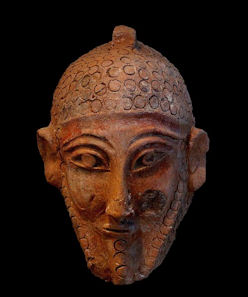 AFP reported: “According to lead study author Lisa Matisoo-Smith, a professor in the department of anatomy at New Zealand's University of Otago, the remains reveal the earliest known evidence in North Africa of a rare European genetic population, or haplogroup, known as U5b2c1. "U5b2c1 is considered to be one of the most ancient haplogroups in Europe and is associated with hunter-gatherer populations there," she said. "It is remarkably rare in modern populations today, found in Europe at levels of less than one percent.The matriarchal DNA of the man, whose remains were found by gardeners working outside the National Museum of Carthage in 1994, "most closely matches that of the sequence of a particular modern day individual from Portugal."
AFP reported: “According to lead study author Lisa Matisoo-Smith, a professor in the department of anatomy at New Zealand's University of Otago, the remains reveal the earliest known evidence in North Africa of a rare European genetic population, or haplogroup, known as U5b2c1. "U5b2c1 is considered to be one of the most ancient haplogroups in Europe and is associated with hunter-gatherer populations there," she said. "It is remarkably rare in modern populations today, found in Europe at levels of less than one percent.The matriarchal DNA of the man, whose remains were found by gardeners working outside the National Museum of Carthage in 1994, "most closely matches that of the sequence of a particular modern day individual from Portugal."
“The discovery sheds some new light on the history of the Phoenicians, who are thought to have originated in Lebanon and spread across the Mediterranean. Carthage was a prominent Phoenician port and trade center established by colonists from Lebanon. However, researchers were unable to find any links between the ancient man's mitochondrial DNA and that of 47 modern Lebanese people who were analyzed for the study. "Hopefully our findings and other continuing research will cast further light on the origins and impact of Phoenician peoples and their culture," said Matisoo-Smith.”
Image Sources: Wikimedia Commons, The Louvre, The British Museum, Bardo Museum
Text Sources: Internet Ancient History Sourcebook: Mesopotamia sourcebooks.fordham.edu , National Geographic, Smithsonian magazine, especially Merle Severy, National Geographic, May 1991 and Marion Steinmann, Smithsonian, December 1988, New York Times, Washington Post, Los Angeles Times, Discover magazine, Times of London, Natural History magazine, Archaeology magazine, The New Yorker, BBC, Encyclopædia Britannica, Metropolitan Museum of Art, Time, Newsweek, Wikipedia, Reuters, Associated Press, The Guardian, AFP, Lonely Planet Guides, “World Religions” edited by Geoffrey Parrinder (Facts on File Publications, New York); “History of Warfare” by John Keegan (Vintage Books); “History of Art” by H.W. Janson Prentice Hall, Englewood Cliffs, N.J.), Compton’s Encyclopedia and various books and other publications.
Last updated February 2024
